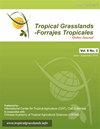Evaluation and reparametrization of mathematical models for prediction of the leaf area of Megathyrsus maximus cv. BRS Zuri
IF 0.9
4区 农林科学
Q3 AGRICULTURE, DAIRY & ANIMAL SCIENCE
引用次数: 2
Abstract
The aim of this study was to verify the precision and accuracy of 5 models for leaf area prediction using length and width of leaf blades of Megathyrsus maximus cv. BRS Zuri and to reparametrize models. Data for the predictor variables, length (L) and width (W) of leaf blades of BRS Zuri grass tillers, were collected in May 2018 in the experimental area of Embrapa Gado de Corte, Mato Grosso do Sul, Brazil. The predictor variables had high correlation values (P<0.001). In the analysis of adequacy of the models, the first-degree models that use leaf blade length (Model A), leaf width × leaf length (Model B) and linear multiple regression (Model C) promoted estimated values similar to the leaf area values observed (P>0.05), with high values for determination coefficient (>80%) and correlation concordance coefficient (>90%). Among the 5 models evaluated, the linear multiple regression (Model C: β0 = -5.97, β1 = 0.489, β2 = 1.11 and β3 = 0.351; R2 = 89.64; P<0.001) and as predictor variables, width, length and length × width of the leaf blade, are the most adequate to generate precise and exact estimates of the leaf area of BRS Zuri grass.巨巨树叶面积预测数学模型的评价与再参数化。BRS Zuri
本研究的目的是验证5种叶片长度和宽度预测模型的精度和准确性。BRS Zuri和重新参数化模型。预测变量叶片长度(L)和宽度(W)的数据于2018年5月在巴西南马托格罗索州加多科尔特农场试验区采集。预测变量具有较高的相关值(P0.05),其中决定系数(>80%)和相关一致性系数(>90%)较高。在评价的5个模型中,线性多元回归(模型C: β0 = -5.97, β1 = 0.489, β2 = 1.11, β3 = 0.351;R2 = 89.64;P<0.001),叶片宽度、长度和长×宽作为预测变量,最能准确、准确地估算出BRS Zuri草叶面积。
本文章由计算机程序翻译,如有差异,请以英文原文为准。
求助全文
约1分钟内获得全文
求助全文
来源期刊

Tropical Grasslands-Forrajes Tropicales
Agricultural and Biological Sciences-Agronomy and Crop Science
CiteScore
1.60
自引率
0.00%
发文量
36
审稿时长
16 weeks
期刊介绍:
The Journal publishes, in English or Spanish, Research Papers and Short Communications on research and development, as well as contributions from practitioners (Farmer Contributions) and Review Articles, related to pastures and forages in the tropics and subtropics. There is no regional focus; the information published should be of interest to a wide readership, encomprising researchers, academics, students, technicians, development workers and farmers.
In general, the focus of the Journal is more on sown (''improved'') pastures and forages than on rangeland-specific aspects of natural grasslands, but exceptions are possible (e.g. when a submission is relevant for a particularly broad readership in the pasture and forage science community).
The Journal will also consider the occasional publication of associated, but closely related, research in the form of an additional scientific communication platform [e.g. a re-make of the former Genetic Resources Communication series of the former Division of Tropical Crops and Pastures of the Commonwealth Scientific and Industrial Research Organisation (CSIRO), Australia].
Areas of particular interest to the Journal are:
Forage Genetic Resources and Livestock Production[...]
Environmental Functions of Forages[...]
Socio-economic Aspects[...]
Topics within the aforementioned areas may include: Diversity evaluation; Agronomy; Establishment (including fertilization); Management and utilization; Animal production; Nutritive value; Biotic stresses (pests and diseases, weeds); Abiotic stresses (soil fertility, water, temperature); Genetics and breeding; Biogeography and germplasm collections; Seed production; Ecology; Physiology; Rhizobiology (including BNF, BNI, mycorrhizae); Forage conservation; Economics; Multilocational experimentation; Modelling.
 求助内容:
求助内容: 应助结果提醒方式:
应助结果提醒方式:


